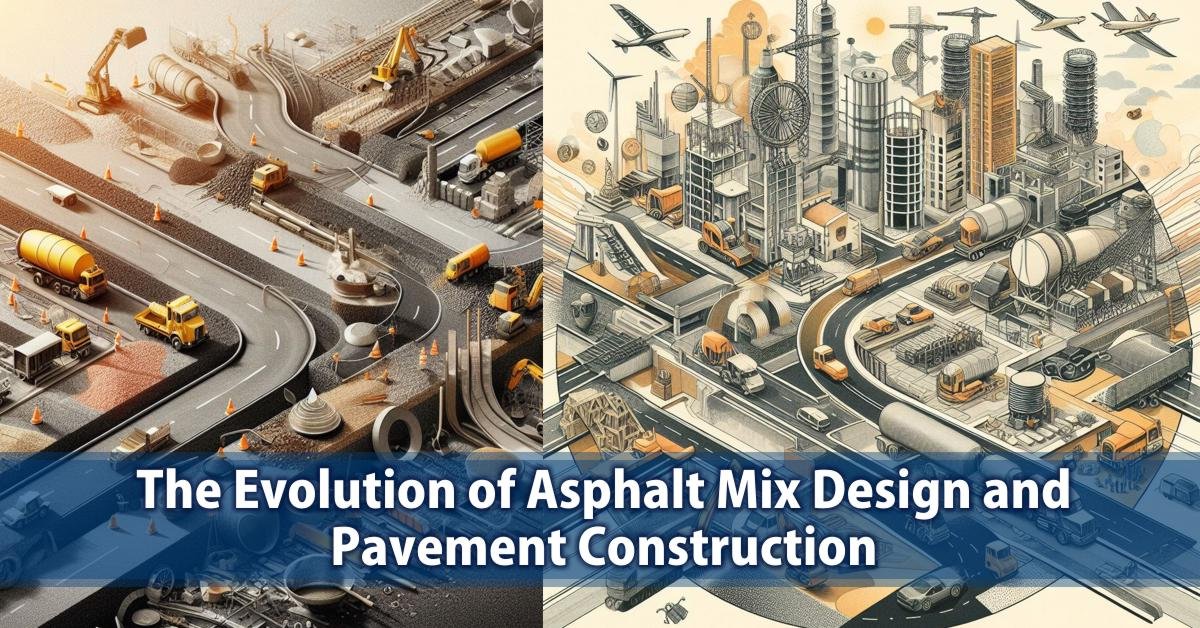Asphalt mix design and pavement construction have evolved significantly over the years, driven by new technologies, increased traffic demands, and a desire for longer-lasting roads. This article provides an informative overview of how asphalt mix design and pavement construction have progressed throughout history. I Steve Axton, a road construction manager will describe the history of hot mix asphalt mixture design in the United States.
Key Takeaways
- Asphalt pavements originated in ancient Babylon in the 7th century BC.
- Early mix designs were basic and proportions were chosen by rule of thumb.
- Major innovations came from Clifford Richardson, Frederick Warren, Francis Hveem, and Bruce Marshall in the early 1900s.
- The Marshall method became the predominant design method until Superpave was introduced in the 1990s.
- Modern mix design focuses on optimizing properties like durability, permeability, and flexibility to suit traffic needs.
Five Facts
- The first asphalt pavements in the US were built in Newark, NJ in 1870.
- The Hubbard-Field stability test was used from the 1920s to the 1950s to design asphalt mixes.
- Superpave uses gyratory compactors and volumetrics to determine optimum binder content.
- Dense-graded, open-graded, and stone matrix asphalt are common mix types today.
- Warm mix asphalt allows lower production temperatures while maintaining workability.
As a licensed civil engineer with over 20 years of experience working with asphalt materials and roadway construction, I’ve seen firsthand how mix design and paving techniques have evolved to meet the demands of modern transportation infrastructure. In my career, I’ve had the privilege of leading successful major highway projects and optimizing innovative warm-mix asphalt processes. On my website CalculatorAsphalt.com, I provide resources for construction professionals looking to improve their pavement engineering and learn from my decades of know-how. In this article, I’ll share my perspective on the progression of asphalt mix design over the years, the advancements that have shaped current best practices, and what the future may hold for pavement construction.
Asphalt mix design and pavement construction have come a remarkably long way over the past century. What began as a simple “rule of thumb” estimation has evolved into a complex engineering discipline underpinning the intricate network of roads and parking lots that make up our transportation infrastructure.

The evolution of asphalt mix design reflects a growing understanding of the scientific principles behind optimizing pavement performance. Researchers like Francis Hveem pioneered new lab testing based on representing real-world conditions, recognizing that compaction and stability were vital to durable roads. Bruce Marshall’s work to achieve maximum density through laboratory compaction helped adapt asphalt for practical needs like wartime airfields.
Modern mix design is now fine-tuned to deliver specific engineering properties tailored to each project’s traffic and climate conditions. Work by SHRP in the late 1900s yielded Superpave representing a fundamental shift to performance-based design. State-of-the-art mixtures are now engineered with an array of technologies to enhance qualities like rutting resistance, moisture susceptibility, and even sustainability through warm mix processes.
Clearly, asphalt mix design has been remarkably shaped by each generation’s innovation and evolving pavement needs over the past 100+ years. Where early experimentation once sufficed, advanced science and precision engineering now enable extremely sophisticated asphalt materials for contemporary applications. Looking forward, one can only imagine where the next century of discovery may take asphalt mix technology and practice. The long trajectory of progress thus far gives hope that asphalt pavements will continue improving hand-in-hand with emerging transportation demands.
Comparison Table
| Era | Mix Design Methods | Technologies Used | Focus |
|---|---|---|---|
| Early 1900s | Hubbard-Field, Triaxial | Basic stability tests | Empirical rules of thumb |
| 1920s-1950s | Hveem, Marshall | Kneading compactors, density | Simulating construction |
| 1970s-1990s | Marshall predominant | Evolving empirical tests | Density, stability |
| 1990s-today | Superpave | Gyratory compactors, volumetrics | Performance-based properties |
https://calculatorasphalt.com/stop-pavement-defects-failures/
Asphalt Mix Design: From Early Empiricism to Modern Engineering
In the early days of asphalt paving, mix proportions were determined arbitrarily without much scientific basis. Researchers like Francis Hveem and Bruce Marshall recognized the need for laboratory techniques that better-simulated field conditions like compaction. Their work in the 1930s and 40s established density, stability, and workability as primary design considerations.
By the 1970s, the empirical Marshall method was predominant across the United States. However, with traffic volumes increasing, the limitations of density-based design became apparent over time. These shortcomings motivated the Strategic Highway Research Program (SHRP) in the late 1980s, which marked a pivotal shift toward performance-based mix design.
Out of SHRP arose the Superpave system, incorporating decades of accumulated knowledge into a state-of-the-art design framework. Superpave uses sophisticated testing like gyratory compaction and balanced mix analysis to engineer HMA for optimum properties:
| Property | Design Impact |
|---|---|
| Durability | Resistance to cracking and weathering |
| Stability | Resists rutting and shoving under loads |
| Permeability | Limits water and air infiltration |
| Fatigue Life | Prevents bottom-up cracking from flexing |
| Workability | Achieves density without segregation |
This represents a dramatic leap from the empirical methods of the past. Today’s mix design leverages computer modeling, quality control testing, and statistical process control to precisely tailor mixtures to site-specific conditions. The result is high-performance pavements designed to handle heavy traffic and endure extreme climates.
https://calculatorasphalt.com/calculate-mass-of-sand/
Paving Innovations Enhancing Quality and Sustainability
Several emerging technologies have captured my interest as a pavement engineer focused on delivering long-lasting, eco-friendly infrastructure:
By adding special waxes or through foaming processes, a warm mix lowers production and placement temperatures while maintaining workability. This provides benefits such as:
- Reduced energy use and greenhouse gas emissions
- Lower exposure to fumes for workers
- Extended paving season in cold climates
Reclaimed Asphalt Pavement (RAP)
Milling old pavement produces RAP that can be incorporated into new mixes. With proper design, high RAP content helps:
- Conserve aggregates and virgin asphalt
- Reduce costs from material savings
- Limit waste and landfill use
Modified Binders
Additives like polymers improve the properties of the asphalt binder itself. Polymer-modified asphalt enhances:
- Rutting resistance
- Flexibility at low temperatures
- Longevity compared to plain binders
https://calculatorasphalt.com/asphalt-temperature-calculator/
The Future of Asphalt Mix Materials and Design
While the foundations of modern mix design took shape in the mid-1900s, optimization, and innovation continue advancing the state of the practice. Here are some frontiers where I see progress continuing:
Data-Driven Design
With expanded computational power and database management tools, mix design can evolve to leverage vast amounts of performance data. This will facilitate more accurate predictive models and simulations to virtually prototype mixtures.
Customized Pavement Materials
Precision construction techniques like 3D printing allow highly customized asphalt materials tailored to specialized applications. Composite aggregates, recycled plastics, and other additives could enable designer mixes, unlike today’s conventional HMA.
Holistic Pavement Management
Integrated solutions from design through maintenance help extend pavement life. Improved construction quality assurance, preservation treatments at the right time, and repair optimization will minimize life cycle costs.
Sustainable Materials and Processes
The drive for sustainability will further improve energy efficiency, reuse waste streams, and conserve virgin materials through technology. Expect pavement sustainability ratings to eventually guide mix design like other building systems.
https://calculatorasphalt.com/calculate-quantity-of-asphalt-in-road/
What’s Happening Now?
Early Empirical Methods Lacked a Scientific Basis
The beginnings of asphalt mix design lacked a proper engineering basis. Early experimentation relied on arbitrary proportions and rudimentary stability tests. This provided a starting point but did not optimize mixtures.
Researchers Developed Laboratory Tests Simulating Field Conditions
Researchers like Hveem and Marshall recognized the need for lab procedures reflecting construction. Kneading compactors and density studies better-replicated field performance. This represented major progress in asphalt mix engineering.
Modern Mix Design Precisely Tailors Properties to Needs
Superpave incorporated major advances in design complexity, considering multiple performance criteria. Technologies continue enhancing the field, with sustainability now joining durability as a key goal. Precision asphalt engineering today creates mixes tailored to each unique application.
Questions answered by Steve Axton
What was one limitation of the Marshall mix design method?
The Marshall method did not perform well for high traffic volumes. This led to the development of Superpave.
How did Superpave change the asphalt mix design?
Superpave introduced a performance-based design focused on optimizing for properties like durability rather than density alone.
What is an example of new technology impacting mix design today?
Warm mix asphalt allows lower production temperatures while maintaining mixture workability and quality.
How has mixed design changed from early empirical methods?
Today’s mix design uses advanced science and engineering principles to optimize mixes for specific conditions.
Why was the SHRP program important for asphalt mix design?
SHRP funded research critical to developing the Superpave system in the 1990s.
What does HMA stand for?
Hot Mix Asphalt
What is gyratory compaction?
Gyratory compactors are used in Superpave to compact HMA specimens for design.
What does VMA stand for?
Voids in the Mineral Aggregate
What is an example benefit of warm mix asphalt?
Lower production temperatures save energy and reduce emissions.
What does OGFC stand for?
Open-Graded Friction Course
